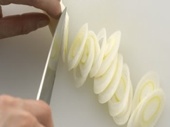 Hello Everyone, hope that you are have a great week so far. Today I’m going to share some basic Cutting Techniques, that I have learn from others and from my mother. Enjoy.
Hello Everyone, hope that you are have a great week so far. Today I’m going to share some basic Cutting Techniques, that I have learn from others and from my mother. Enjoy.
☆ Vegetables Cutting Technique ☆
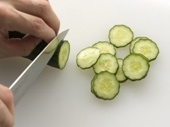 ♦ Rounds(輪切り/Wagiri) ♦
♦ Rounds(輪切り/Wagiri) ♦
Ingredients into rounds. Peel the ingredient thinly, and slice it crosswise for rounds of uniform thickness. The thickness depend on how the ingredient is to be used in dishes.
*Use for Carrot, White radish, Eggplant, and other cylindrical vegetables.
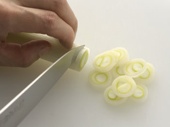 ♦ Edge Cut(小口切り/Koguchi-giri) ♦
♦ Edge Cut(小口切り/Koguchi-giri) ♦
The vegetables into rounds. When slicing , make sure that the thickness in uniform.
*Use for Burdock, Naganegi-onion, Cucumber, and other cylindrical vegetables.
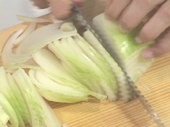 ♦ Thin Slice(薄切り/Usugiri) ♦
♦ Thin Slice(薄切り/Usugiri) ♦
The vegetables from one end into rounds of about 1㎜ thickness. Slicers are hardy for realizing a more uniform finish.
*Use for Onion, White radish, and other vegetables.
 ♦ Diagonal Cut(斜め切り/Naname-giri) ♦
♦ Diagonal Cut(斜め切り/Naname-giri) ♦
The vegetables cut into diagonally. Make sure that the thickness is uniform.
 ♦ Rolling Wedges(乱切り/Rangiri) ♦
♦ Rolling Wedges(乱切り/Rangiri) ♦
Make diagonal cuts while rotating vegetables a quarter between cuts.
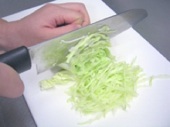 ♦ Julienne Strips(せん切り/Sengiri) ♦
♦ Julienne Strips(せん切り/Sengiri) ♦
The vegetable should be cut in the same direction as their again. (but very thinly about 1㎜ thick)
*Use for Cabbage, Lettuce, Green Perilla etc
♦ Half-Moon(半月切り/Han-getsu- giri)♦
The vegetable in half-moons. Cut vegetables in half lengthwise, and then slice them crosswise.
*Use for Carrot, White radish, Cucumber, and other cylindrical vegetable.
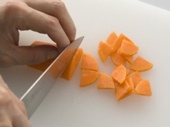 ♦ Quarter-Rounds(いちょう切り/Icho-giri) ♦
♦ Quarter-Rounds(いちょう切り/Icho-giri) ♦
The vegetables into quarter-rounds. Cut vegetables in quaters lengthwise, abd then slice them crosswise. Make sure that the thickness in uniform.
*Use for Carrot, White radish, and other cylindrical vegetables.
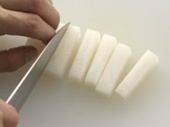 ♦ Bar-Rectangles(拍子切り/Hyo-shi- giri) ♦
♦ Bar-Rectangles(拍子切り/Hyo-shi- giri) ♦
Cut vegetables into 3-4 ㎝ length. Cut them in the same direction as their grain into rectangles of 5-6 ㎜ thickness. Lay them on their side , and cut them into bars of 5-6 ㎜ thickness.
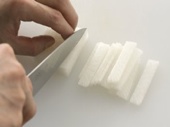 ♦ Rectangles(短冊切り/Tanzaku-giri) ♦
♦ Rectangles(短冊切り/Tanzaku-giri) ♦
Cut vegetables into 4-5 ㎝ lengths. Cut them thinly in the same direction as their grain. Lay them on their side, and cut them into rectangles of about 8㎜ thickness.
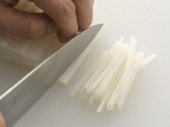 ♦ Thin Cut(細切り/Hosogiri) ♦
♦ Thin Cut(細切り/Hosogiri) ♦
Cut vegetables into 4-5 ㎝ lengths. Cut them lengthwise in the same direction as their grain into rectangles of about 2 ㎜ thickness. Lay them on their side, and cut them into thin pieces of about 2 ㎜ thickness.
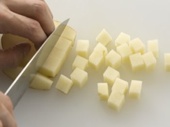 ♦ Cube Cut(さいの目切り/Sai-no- me- giri) ♦
♦ Cube Cut(さいの目切り/Sai-no- me- giri) ♦
Cut bar rectangles from one end into cubes of about 1 ㎝ thickness.
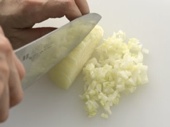 ♦ Fine Chopping(みじん切り/Mijin-giri) ♦
♦ Fine Chopping(みじん切り/Mijin-giri) ♦
example; Onion
Cut onion in half lengthwise. Then, with the cut face down, slice them into pieces of about 5 ㎜ thickness. Make sideway cuts. Cut them finely from one end.
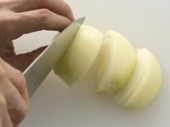 ♦ Wedge Cut(くし切り/Kushi-giri) ♦
♦ Wedge Cut(くし切り/Kushi-giri) ♦
A techniques used for cutting tomatos, orange, lemons and other spherical foods into wedges. Cut foods lengthwise in sixths or eighths.
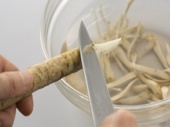 ♦ Shavings(ささがぎ/Sasagaki) ♦
♦ Shavings(ささがぎ/Sasagaki) ♦
Scrape off the burdock skin with a tawashi kitchen brush or using the back of a knife. Make a lengthwise cross-shape incision about 5 ㎝ deep at one end, and cut it from that end as if you were sharpening a pencil while rotating little by little with the other hand.
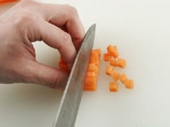 ♦ Dice Cut(あられ切り/Arare-giri) ♦
♦ Dice Cut(あられ切り/Arare-giri) ♦
Cut vegetables into 4-5 ㎝ lengths. Then, cut them lengthwise into rectangles of about 5 ㎜ thickness as in the bar rectangles technique. Cut them from one end into 5 ㎜ cubes.
*Cubes with a size smaller then of the Cube cut.
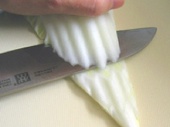 ♦ Shaving Cut(そぎ切り/Sogi-giri) ♦
♦ Shaving Cut(そぎ切り/Sogi-giri) ♦
A technique used for shiitake mushroom and chinese cabbage. Shave vegetables thinly using the knife in such a way that it is almost laid on its side.
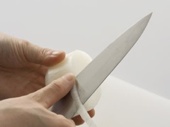 ♦ Bevel-edged Cylinders(面取り/Men-tori) ♦
♦ Bevel-edged Cylinders(面取り/Men-tori) ♦
A technique often used for white radish and potatoes, etc. Edges of ingredients are beveled for neat appearance. Apply the knife to the edge of an ingredient at a certain angle, and rotate the ingredient with the left hand.
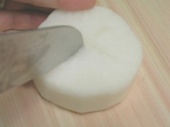 ♦ Penetration-Facilitating Cut(隠し包丁/Kakushi-bouchou)♦
♦ Penetration-Facilitating Cut(隠し包丁/Kakushi-bouchou)♦
Make a cross-shape incision form one end of a bevel-edge cylindrical ingredient up to about 1/3 of the length. This will facilitate the penetration of seasoning and heat when simmering them.
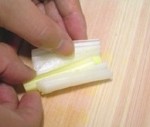
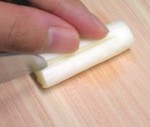
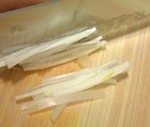
♦ Naganegi-Onion “Gray Hair” Cut(白髪ねぎ/Shiraga-Negi) ♦
Cut the white portion of naga-negi onions into 4-5 ㎝ lengths. Make an incision in their center to remove the soft green core. Cut them thinly as in the julienne strips techniques.
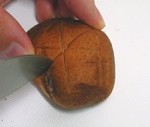
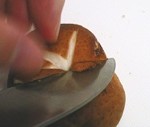
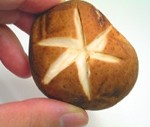
♦ Shiitake Decorative Cut(しいたけの飾り切り/Shiitake-no-Kazari-giri) ♦
Make three incision on top of each shiitake mushroom, and bevel these cut by inserting the knifediagonally into them.
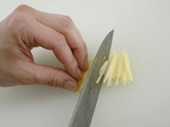 ♦ Ginger Needles(針しょうが/Hari-sho-ga) ♦
♦ Ginger Needles(針しょうが/Hari-sho-ga) ♦
Slice peeled ginger thinly. Then, cut a stack 4 to 5 slice in the same direction as their grain into thin needle-like shapes.

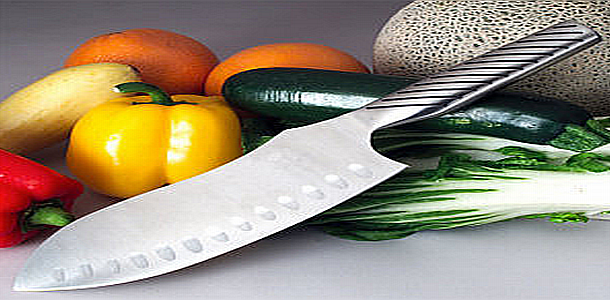












This is a wonderful instructional post. Well done! Happy New Year now, OR in a month!
very competitive…..:)
be present in the gulf countries….
~KAWAII…~